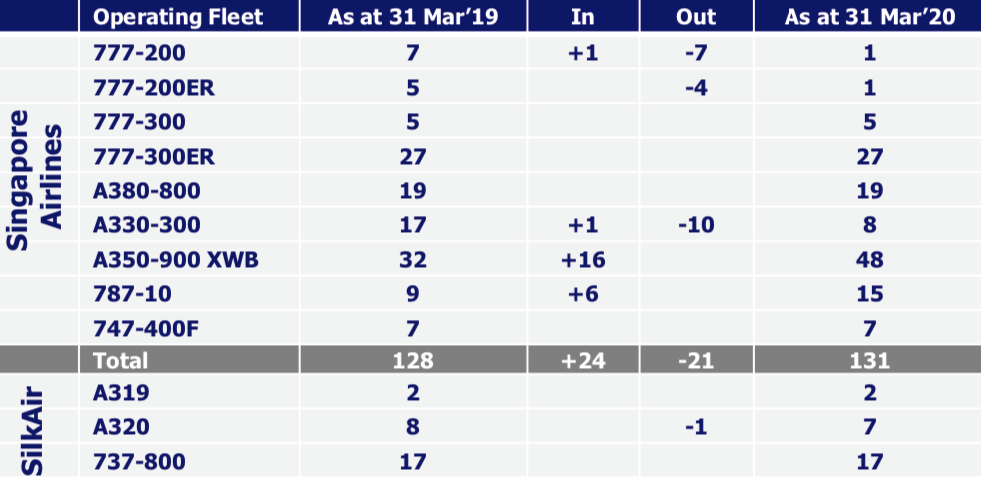Highlights:
- The 737 MAX 8 grounding issue has prompted Singapore Airlines to scrap plans to transfer 737-800s from SilkAir to Scoot;
- Singapore Airlines may retrofit 737-800s with lie flat business class seats, enabling it to keep its pledge to transition to a 100% lie flat fleet;
- Singapore Airlines has also placed back into service 777-200s and A330-300s with its old regional business class product but this is a temporary measure.
CAPA - Centre for Aviation highlighted a year ago about SIA's ambitious plans to become the first major airline to offer exclusively lie flat seats in business class. The project involves introducing lie flat seats on all full service narrowbody aircraft (currently operated by SilkAir but in future operated by Singapore Airlines as the former is being absorbed by the latter) as well as its regional widebody fleet.
SEE RELATED REPORT: Singapore Airlines raises the stakes, commits to 100% lie flat fleet following SilkAir merger
SIA still operates 31 widebody aircraft with angled flat seats in 2-2-2 configuration. All 27 narrowbody aircraft operated by SilkAir and the six 737 MAX 8s that are grounded have recliner style business class seats in 2-2 configuration.
The group's pre-MAX grounding fleet plan included retrofitting the six 737 MAX 8s that are now grounded as well as another nine 737 MAX 8s that were slated to be delivered in the current fiscal year ending Mar-2020. The first of the MAX 8s with lie flat seats were slated to be placed into service in 2020.
Within a few years the plan was for SIA to operate an all-MAX narrowbody fleet with all aircraft featuring the new lie flat product and seatback IFE in both cabins, phasing out the SilkAir brand as the older aircraft without lie flat and without seatback IFE were retired.
SilkAir currently operates 10 A320 family aircraft and 17 737-800s (excludes the six grounded MAX 8s). The group had been planning to sell or return the Airbuses (most are owned) and sell three of the 737-800s while transferring 14 737-800s to Scoot.
The newly revised fleet plan still includes phasing out the eight A320s and two A319s - although some of these will be extended for a short period. However, the plan for transferring the 14 737-800s has now been scrapped. SIA now plans to keep these aircraft at SilkAir to offset the capacity impact from the MAX grounding and the deferral of the nine aircraft previously slated to be delivered in the current fiscal year. The three 737-800s that were to be sold will likely still be sold but SIA has the flexibility to reassess this as these aircraft were not going to be sold for a few years.
Scoot will no longer operate a mixed narrowbody fleet, which was hardly ideal to begin with given the additional cost associated with operating 737s alongside A320s. It has cut its capacity growth plans - and is now projecting 7% ASK growth this fiscal year compared to 15% last year - and is planning to lease additional A320s.
For the SilkAir fleet (future Singapore Airlines narrowbody fleet) there is still a lot of uncertainty. SIA is looking at retaining the 737-800s, which could lead to a reduction in its 737 MAX 8 order. However, it is too early to make any conclusions on whether SIA will still transition to an all-MAX narrowbody fleet, when it will reactivate its six grounded MAX 8s and when it will resume MAX 8 deliveries. For now, it is assuming zero MAX deliveries in the current fiscal year.
What is certain is SIA will still transition to an all lie flat fleet. This could require SIA retrofitting some or all of its 737-800s, using the kits initially acquired for MAX 8s. "The long and short answer is that we want the lie flat product," SIA Group CEO Goh Choon Phong said at the airline's annual results briefing.
"Whether or not we configure it on the NG [737-800] will be something that we'll make a call on, but it is too early to make that call at this point in time because we don't know how long exactly we will have to retain NG at this point in time. We have flexibility built in, of course in terms of leases as well as some of those that we own."
SIA also still plans to phase out its 777-200s, 777-300s and A330-300s over the next few years, as The Blue Swan Daily outlined in Apr-2018. These types do not have full lie flat seats while the rest of the airline's fleet all has lie flat and all aisle access (777-300ERs, 777-200ERs, A380-900s, A350-900s and 787-10s).
SEE RELATED REPORT: Corporate Update: Singapore Airlines to offer lie flat product on all flights by 2023
SIA recently reactivated one 777-200 and one A330-300 as it needed to offset capacity lost from the grounding of 737 MAX 8s and some 787-10s due to Rolls-Royce engine issues. However, by the end of this fiscal year it plans to remove seven 777-200s and 10 A330-300s as more 787-10s and regional configured A350-900s are delivered.
As a result, Singapore Airlines will be down to only 14 aircraft (eight A330-300s, five 777-300s and one 777-200) without lie flat in Apr-2020 compared to 31 currently. The group will not yet have any lie flat narrowbody aircraft in Apr-2020 but should quickly be able to transition from zero to 100% lie flat over the subsequent few fiscal years.
CHART - SIA and SilkAir's revised fleet plan for the fiscal year ending Mar-2020  Source: Singapore Airlines FY2019/20 results presentation (NOTE: SIA Group has excluded the 737 MAX 8s from its current FY2020 fleet plan due to the grounding)
Source: Singapore Airlines FY2019/20 results presentation (NOTE: SIA Group has excluded the 737 MAX 8s from its current FY2020 fleet plan due to the grounding)